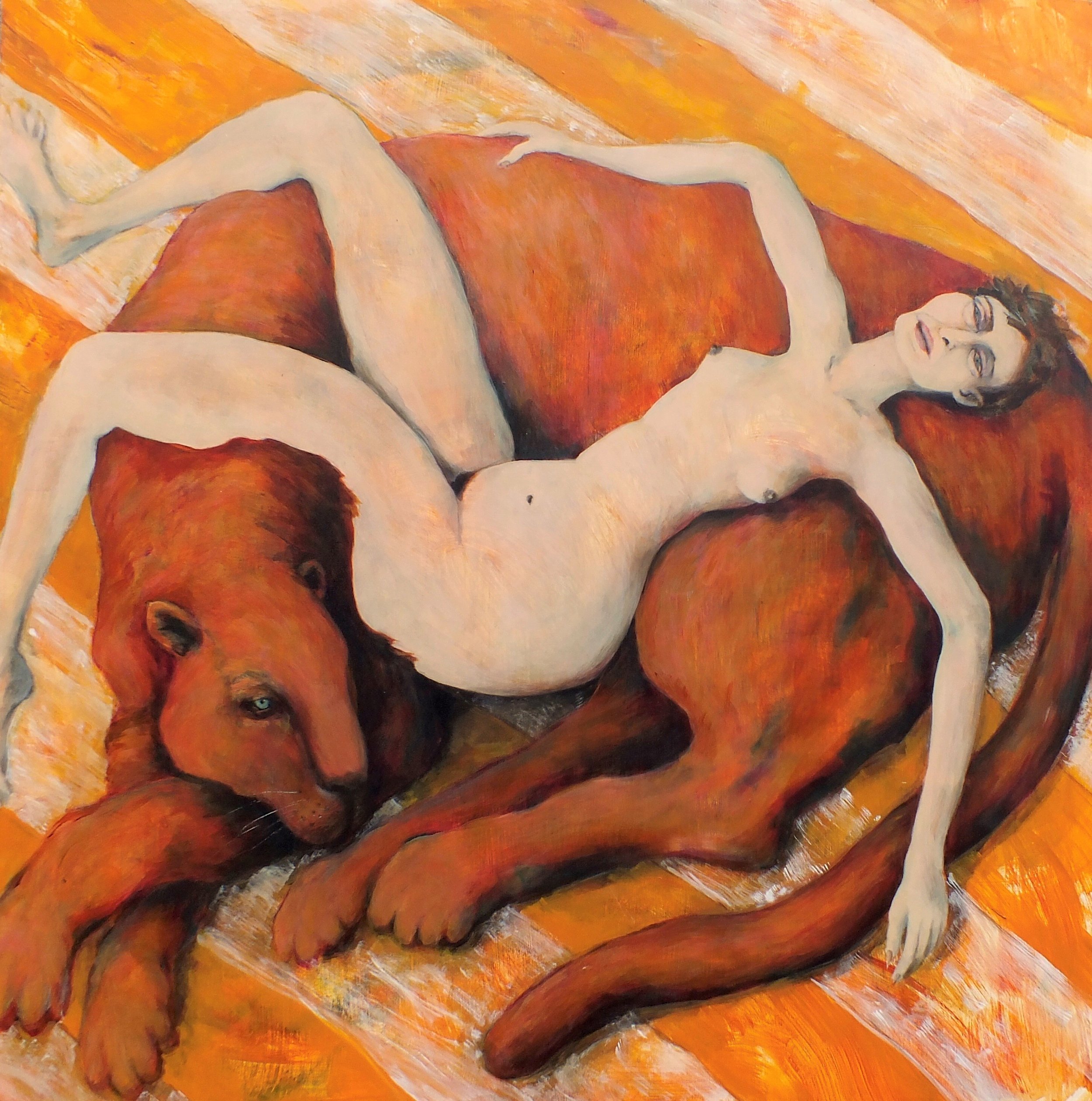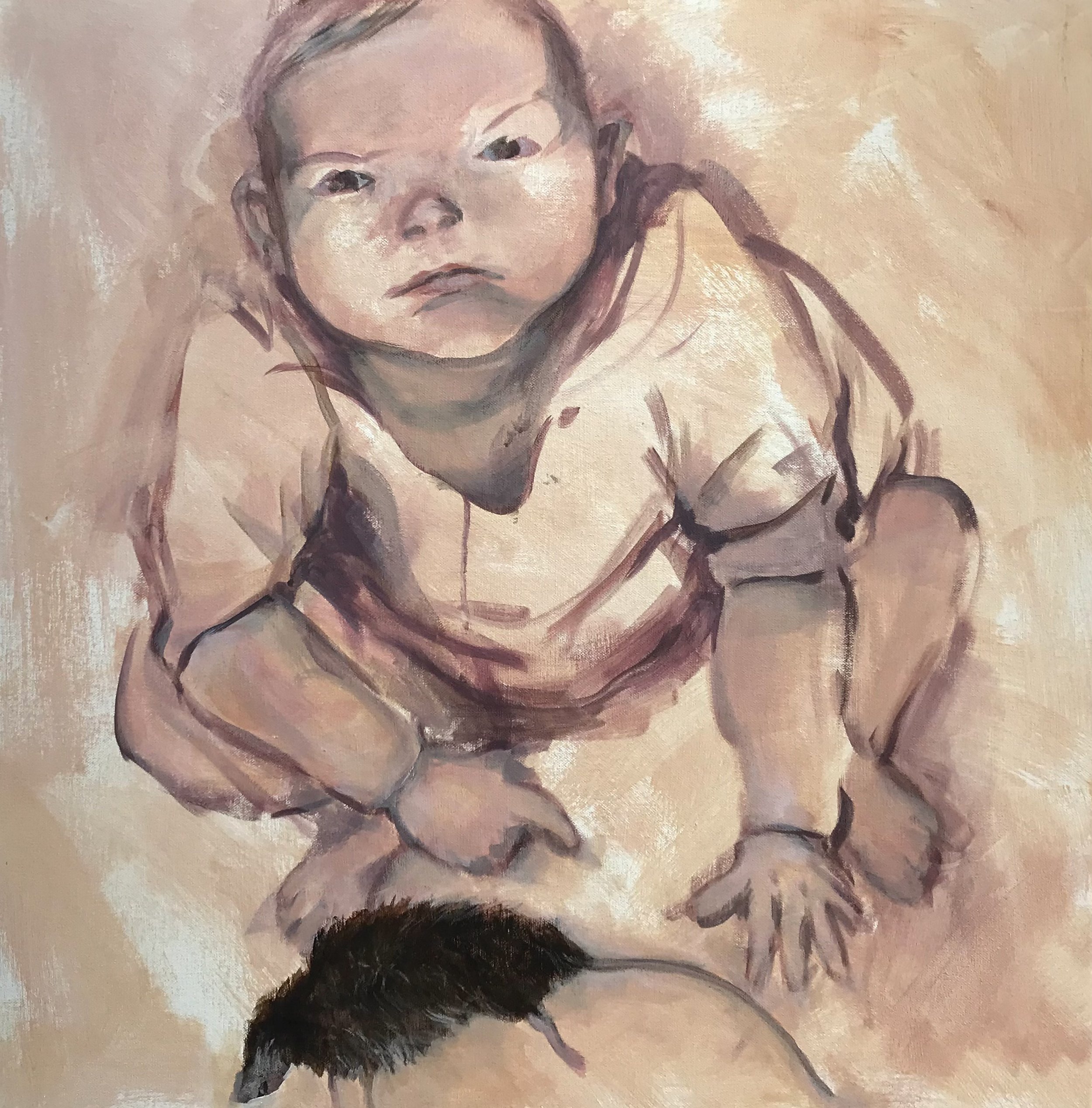Bestial Dissonance
An Interview with Yolande Armstrong
For the Newlyn Society of Artists Exhibition Engage
I am interested in flesh. Our physical reality is one of flesh: it is the most obvious thing we see.
Yolande welcomes me through her front door and leads me to her studio. It is the first room off the corridor, an intimate space filled with works in progress, past pieces, and an abundance of books. I am offered tea, which her partner kindly brings to us. Beasts made of human bodies and animal heads stare down at us from the walls as we sip, twisting and cavorting in their canvases as if straining to be released from the parameters of the paintings. One piece catches my eye, an image of a child squatting toad-like before a stiff dead rat. I ask her about this piece, its contrasting images both disturbing and intriguing me.
YA: Something in my work is about dissonance, a dissonance between the familiar and the unexpected and this, to me, is what ‘engage’ means: creating discord which makes people double-take.
KRE: Can you talk to me about the animals which are often the subjects of your paintings?
YA: I am interested in what makes a person a person or a beast a beast, what parts of us are beastly and not beastly. We are, after all, beasts: we’re animals, we’re vulnerable, we’re flesh. I like to examine what type of animals we are, sometimes we are cruel, the cruellest some might say, but we are also full of compassion and care.
KRE: Your work deals with the darkness inside ourselves, revealing and potentially celebrating our beastliness, what has been the focus for you for this show?
YA: I have been experimenting with the naked figure more. I am interested in flesh.
Our physical reality is one of flesh: it is the most obvious thing we see. As we get older, our flesh doesn’t really represent us. People don’t know you for who you are: suddenly you’re a nobody, an old woman who isn’t remotely interesting. The most intimate way of making contact is through our skin. That’s how we perceive the world: through our physicality.
Previously, I didn’t want to add to a patriarchal voyeuristic context by putting the naked female figure on display, but these figures have come out of working with my own anger and feelings. I know the female experience; it is a rich and complex one. I paint them in a certain way. They are not titillating: often fists are clenched, and muscles tensed showing rage and strength.
KRE: How have you responded to the title of the show, ‘Engage’?
YA: Art is always about engaging. I am interested in people, the way the present themselves, their identities, and their interior processes. I am more and more interested in the effects of time and memories as I get older. We are bodies and brains, this incredible accretion of memories which make us who we are. The older we get, the more memories we have and am interested in exploring how this collection of experiences works to create a person.
The NSA show is titled ‘Engage’ because of arts ability to connect with people, to make them think differently.
Another element of the show is the inclusion of augmented and virtual reality
elements combined with physical pieces. Five artists had the opportunity to work with NSA member Tanya Krzywinska, a research professor working with Immersive Games and Technologies at Falmouth University. This is a new realm for the NSA and many of its artists, so I was curious about Yolande’s thoughts on the combination of material and digital art.
KRE: Why do you think it’s important to bring art into the digital realm?
YA: I think it’s crucial. It’s another, different way of working. When we have included digital elements in our shows before, things like short films, it has always been really successful, so this is another way of moving forward and taking risks. The NSA is continually pushing the boundaries and showing work which is relevant and exciting. This show, with its digital element, continues the dynamism we are celebrating.
I bring the conversation round to the centenary celebration of the Victorian philanthropist Passmore Edwards, which Engage is part of. Edwards was a figure for huge change in Cornwall and across England, building institutions like the Newlyn Art Gallery and The London School of Economics. Edwards funded 70 public buildings, including libraries, educational institutions, art galleries and hospitals in London and Cornwall and campaigned for reform on several important social issues such as education, abolition of slavery, the health service and social housing.
KRE: Why do you think it’s important that we are celebrating Passmore Edwards?
YA: Passmore Edwards was a champion of innovation. He pushed the boundaries and got art out to people who hadn’t been able to access it. This is what Tanya is doing with her digital work: creating a new way to engage with art and exciting people who perhaps wouldn’t access art usually. The creative arts are being eroded at a fast rate and they are crucial to wellbeing. Changing people’s perceptions of what art is and who can access and make it is essential.
The interview naturally drifts into casual conversation. Yolande asks about my work, and we discuss the importance of giving time and space to creative practice. She leaves me with this, ‘I love painting, I just need to do it,’ and you can see this infatuation in every stroke of the brush.
For more information: https://yolandebigfish.wordpress.com



